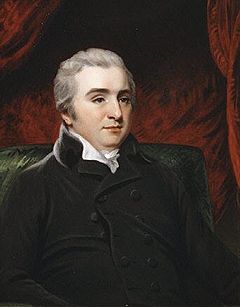Matthew Baillie facts for kids
Quick facts for kids
Matthew Baillie
|
|
|---|---|

portrait by Henry Bone after John Hoppner
|
|
| Born | 27 October 1761 |
| Died | 23 September 1823 (aged 61) |
| Nationality | Scottish |
| Alma mater | University of Glasgow University of Oxford |
| Scientific career | |
| Fields | medicine pathology |
| Institutions | Royal College of Physicians |
Matthew Baillie FRS (1761–1823) was an important British doctor and scientist. He was a pathologist, which means he studied diseases and how they affect the body. He is famous for being the first to identify two rare medical conditions: transposition of the great vessels (TGV) and situs inversus.
Contents
Early Life and Education
Matthew Baillie was born on October 27, 1761, in a town called Shotts in Scotland. His father, James Baillie, was a professor at Glasgow University. His mother, Dorothea Hunter, had two very famous brothers who were also doctors: Dr. John Hunter and Dr. William Hunter. Matthew also had a sister, Joanna Baillie, who became a well-known poet.
Matthew went to the Old Grammar School of Hamilton. Later, he studied at the University of Glasgow and then at the University of Oxford. He earned his medical degree (MD) from Oxford in 1789. He learned a lot from his uncle, the anatomist John Hunter, and his father-in-law, Dr. Thomas Denman, who was a leading expert in childbirth.
Medical Career and Discoveries
When his uncle, William Hunter, passed away in 1783, Matthew inherited a large sum of money. He also received his uncle's house in London and a medical school and museum next to it. Matthew taught at this medical school from 1783 to 1803.
In 1789, he became a doctor at St George's Hospital. He also taught anatomy there. Later, he left these jobs to start his own medical practice. He became a personal doctor to King George III. In 1790, he became a Fellow of the Royal College of Physicians. This meant he was a highly respected doctor. He focused on studying how diseases changed the body's organs.
Matthew Baillie was also elected a Fellow of the Royal Society in 1790. This is a very old and respected group for scientists. In 1791, he gave a special lecture to the society about muscles.
Important Medical Book
In 1793, Matthew Baillie wrote a very important book called The Morbid Anatomy of Some of the Most Important Parts of the Human Body. This book was the first of its kind to systematically study pathology in English. It explained how different diseases affected the human body.
This book was very popular and was translated into many languages. It helped doctors around the world understand diseases better. In this book, he was the first to describe two conditions:
- Transposition of the Great Vessels (TGV): A serious heart condition where the two main arteries leaving the heart are swapped.
- Situs Inversus: A rare condition where a person's major organs (like the heart, liver, and stomach) are on the opposite side of the body from where they usually are.
Death and Legacy
Matthew Baillie passed away on September 23, 1823, at the age of 61. He died from tuberculosis, a serious lung disease. He was buried in Duntisbourne Abbots, England. There is also a special memorial to him inside Westminster Abbey in London, which includes a bust (a sculpture of his head and shoulders).
Family Life
Matthew Baillie was married to Sophia Denman. She was the sister of Thomas Denman, 1st Baron Denman, who was a famous lawyer and judge.
Key Publications
Matthew Baillie wrote several important books and papers during his career. His most famous work was his book on morbid anatomy.
- The Morbid Anatomy of Some of the Most Important Parts of the Human Body (1793)
- Anatomy of the Gravid Uterus, by William Hunter published by Baillie (1794)
- A Series of Engravings, tending to illustrate the Morbid Anatomy of some of the most Important Parts of the Human Body (1799, 1802, 1812)
See also
- Hunterian Collection

